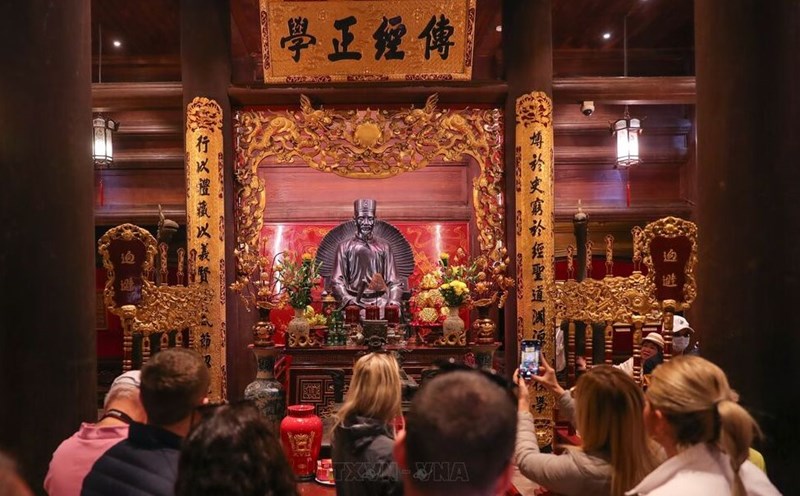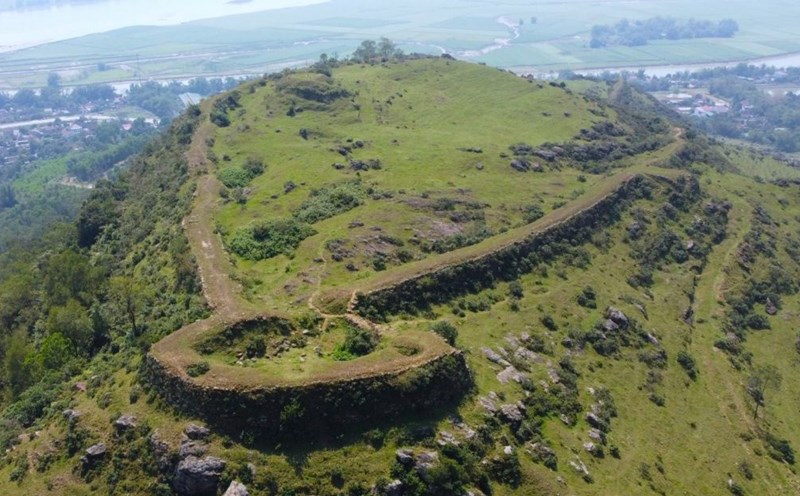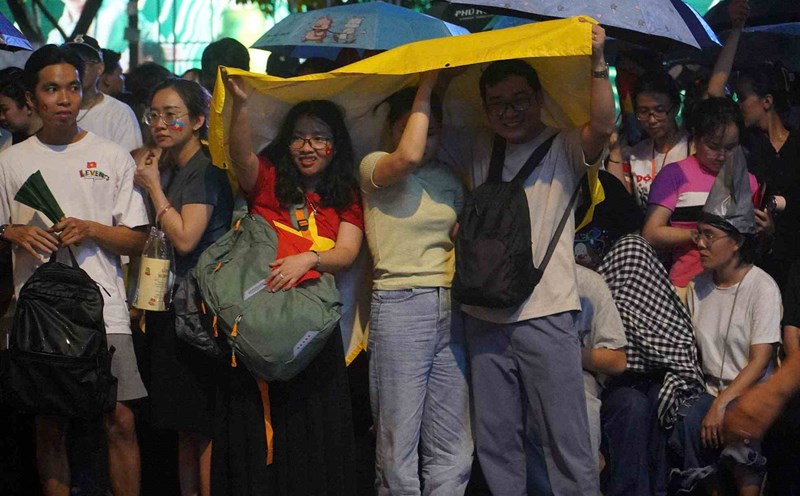National Religious Center
Quan Linh Tien also has another name, Cao Xa Pagoda. According to many sources, this relic dates back to at least the Mac Dynasty. According to local people and scholars, the name Quan Linh Tien appeared from the end of the Le Trung Hung Dynasty, the beginning of the Nguyen Dynasty.
According to the stone stele with an additional side carved under the reign of King Le Kinh Tong in the 18th year of Hoang Dinh (1618), Quan Linh Tien was built in the 2nd century BC. During the Trieu Dynasty, when Lu Gia passed through this land, he saw the fairies playing chess and ordered his soldiers to build Quan Linh Tien for Taoist priests to practice. During the Tran Dynasty, Quan Linh Tien was renovated and expanded and was given many blessings. People worshiped the gods, and from here Quan Linh Tien became a major Taoist center of the whole country.
Linh Tien Temple continued to be a place for monks to practice for hundreds of years. During the Mac Dynasty, the temple continued to be restored by royal relatives and nobles. At the end of the Le Trung Hung Dynasty, Taoism became obscure in Vietnamese society, from which Buddhist elements were breathed into Taoist architecture.

Hybrid architecture, unique way of worship
According to legend, Quan Linh Tien is located on a high, spacious land, the architecture facing the Southeast in the style of "Tien Chuong, Hau Khanh". During the reign of King Mac Mau Hop, in the 7th year of Dien Thanh (1584), Da Quoc Cong Mac Ngoc Lien and his wife donated money and launched a major renovation, the architecture was turned to the Northeast, and to this day the main architectural direction is still kept intact.
Currently, Linh Tien Temple consists of main structures along a vertical axis. The main structures include: Tam Quan, Duoi Temple, Thieu Huong Temple, Tren Temple and bell tower. Linh Tien Temple also has other structures such as: To House, Mau House and tower garden.
The Tam Quan is built in a 2-storey, 8-roof style with 3 compartments and 2 wings. The upper floor hangs a bronze bell, the lower floor is an empty space leading to the inside. From the Tam Quan, through a brick yard, leads to the main worshiping architectural area in the shape of the letter "Cong" including: Quan Duoi (Front Hall), Thieu Huong, Quan Tren (Upper Hall). Quan Tren and Quan Duoi are two 5-room, 2-wing buildings. Thieu Huong is a tube-shaped house connecting Quan Tren and Quan Duoi. Behind Quan Tren is a Phuong Dinh building built in a 2-storey, 8-roof style. The upper floor hangs a bronze bell, and the lower floor has a stone stele.
At the Lower Temple, there is a Buddhist Tam Bao altar, on the main altar there are statues of Chuan De, Cuu Long altar, seven statues of That Bao Nhu Lai, on both sides are two statues of Khuyen Thien and Truong Ac. Especially here there are also statues of Ly Quoc Su (Nguyen Minh Khong), King Tran Minh Tong, Tam Quan Dai De and many statues of Hau.
Running along the line connecting the Lower and Upper Pavilions is the Thieu Huong Pavilion, in the center is the statue of the Jade Emperor, on both sides are Nam Tao and Bac Dau and the Fairies. Below are two rows of Mandarins, in front is the statue of Thai Thuong Lao Quan riding a buffalo.
In the center of the temple are 3 statues of Tam Thanh with a size of more than 2m, surrounded by the worship of: De Thien, De Thich, Cuu Thien Huyen Nu, Van Xuong De Quan, Tran Vu, Khong Tu... Especially in the temple there is also worship of Hung Dao Vuong - Tran Quoc Tuan and Hau Than is Da Quoc Cong Mac Ngoc Lien and his wife (who had the merit of restoring Linh Tien Quan). Below the worship of Cuu Thien Huyen Nu there is an ancient well, according to legend, in the past Taoist priests dug to get salvia to make elixir.
As a place that has gone through many ups and downs in the history of the country, its function has also changed according to social changes. Today, Quan Linh Tien is a rare religious and belief place that clearly shows religious syncretism. Despite the religious syncretism, the worship space for the main deities is still divided into clearly separate areas with Taoism, Confucianism and Buddhism.
Existing through hundreds of years of history, Quan Linh Tien still preserves hundreds of precious and rare artifacts made from many different materials. The pagoda still preserves up to 100 statues dating from the Le Trung Hung period to the Nguyen dynasty; some wooden artifacts such as robes, votive doors, horizontal lacquered boards - parallel sentences and scrolls. Notably, there is a scroll hanging in the middle room talking about the origin and position of Quan Lien Tien with 4 verses: "Dan Son Tu Quan Nhat Linh Tien/Te nhan bi van Trieu Viet tien/Hoa tai gia nhien thach bo dia/Khai kim thuong tai sa huyet thien". The poem has the following meaning: "Dan Phuong land has four temples, Linh Tien is the largest/Recording the stele recording that the temple existed from the Trieu dynasty/Faith in the teachings of the Buddhist land/Since the temple was established, it has created a place for alchemy".

At Phuong Dinh house behind the restaurant, there is a special stone stele placed here, the size of the stele is 0.7x1.15m, the bottom is supported by a turtle. The original stele was engraved under Mac Mau Hop, the first year of Doan Thai (1586), the stele's forehead is elaborately carved with typical patterns of the Mac Dynasty such as: Sun, cloud tassels, vines. The stele's inscription records the communes of Dan Phuong, Tu Liem, Thach That districts of Quoc Oai prefecture, Son Tay province together to repair the restaurant, and also records the names of the meritorious people, the most meritorious person is the couple Da Quoc Cong Mac Ngoc Lien. Under King Le Kinh Tong in the 18th year of Hoang Dinh (1618), the stele was engraved with additional text on the other side, recording the history of the restaurant.
In the bell tower of the pagoda, there is still preserved a large bell measuring 1.4m high, cast during the Tay Son Dynasty in the 5th year of Canh Thinh (1797). On the main gate, there is also a bronze gong cast during the Nguyen Dynasty. In the pagoda, there is still an altar, a palanquin, and a pair of wooden cranes, all dating from the Later Le Dynasty. On the road from the main gate leading to the Lower Temple, in the pagoda yard, there is still a set of stone crocodiles from the Le Dynasty.
In particular, Quan Linh Tien still preserves a leather drum, this drum is famous throughout the region, and is popularly known as "Hong Pagoda Bell, Linh Tien Drum". Every year on the 13th day of the 2nd lunar month, the people, together with the local government and Quan Linh Tien organize the Cao Xa village festival, holding a festival to welcome visitors from all over the country.
With the unique "Thuong gia ha kieu" architecture, resembling the shape of a flying dragon, the hundred-year-old bridges in Nam Dinh such as: Luong market tile bridge (Hai Hau district), Kenh village tile bridge (Truc Ninh district), Thuong market tile bridge (Nam Truc district)... all retain their ancient features, lying on the clear blue water, creating a landscape with the charming beauty of the Vietnamese countryside.











